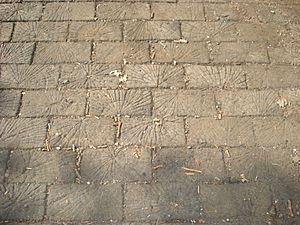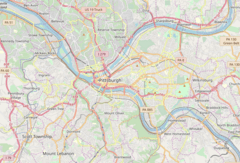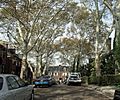Roslyn Place (street) facts for kids
 |
|
| Location | Roslyn Place (Shadyside (Pittsburgh)), Pittsburgh, Pennsylvania, USA |
|---|---|
| Coordinates | 40°27′12.74″N 79°56′9.94″W / 40.4535389°N 79.9360944°W |
| Built/founded | 1914 |
| Architect | Thomas Rodd |
| Governing body/ |
City of Pittsburgh |
| CPHD designated | May 25, 2017 |
| PHLF designated | 1976 |
Roslyn Place is a special street in the Shadyside neighborhood of Pittsburgh, Pennsylvania. It's a small street that ends in a circle, also known as a cul-de-sac. What makes Roslyn Place unique is that it's paved with wood blocks, using a method called Nicolson Pavement. This historic street was built in 1914 and is home to the famous Roslyn Place district.
Contents
Discovering the History of Roslyn Place
The land where Roslyn Place now stands had many different owners over the years. In 1904, a man named Thomas Rodd bought the area. Thomas Rodd was an engineer who came to the United States from London, England, when he was five years old. He served in the navy for a short time during the American Civil War. Later, he joined the Pennsylvania Railroad Company.
Who Was Thomas Rodd?
Thomas Rodd became a very important engineer for the Pennsylvania Railroad. He was in charge of all the train lines west of Pittsburgh. In 1889, he and his family moved to Pittsburgh. Rodd was also known for designing and building many structures in western Pennsylvania and the Midwest. He was the one who designed and paid for the construction of the Roslyn Place district and the street itself.
Building the Wooden Street
Construction of Roslyn Place began in 1914. The Pittsburgh City Council approved the plans for the street. It was built using the Nicolson Pavement style, which means it was paved with wooden blocks. About 26,000 oak blocks were used to create the street! The construction was finished later that same year.
Restoring Roslyn Place
For many decades, Roslyn Place stayed in good condition with only small repairs. However, by the 1980s, the wooden street had started to wear out a lot. In 1985, the city decided to do a big restoration project. They made many important repairs to bring the street back to life. Since then, only minor repairs have been needed, using extra materials from the 1985 project. In 2016, a group called Preservation Pittsburgh suggested that Roslyn Place become a City Historic Landmark.
The Unique Architecture of Roslyn Place
Roslyn Place is special because it's one of the very few places left in the United States that still has Nicolson Pavement. This paving method was invented by Samuel Nicolson in 1859. It involves laying down wooden blocks that have been soaked in a special liquid called creosote.
Why Wooden Streets?
Wooden streets had several advantages compared to other paving types like cobblestone or Belgian block.
- Easier to Travel: Cobblestones had rounded edges, which made it hard for horses to get a good grip. Belgian blocks were a bit better, but their rounded edges still made it tough for wagon wheels. Nicolson Pavement, however, was flat. This made it much easier for people walking, wagons, and horses to move around.
- Less Noise: Wooden streets were quieter than stone streets.
- Better for Horses: The flat, wooden surface was more comfortable for horses to walk on.
- Lower Costs: Building wooden streets was often cheaper.
- Increased Property Value: There was even evidence that buildings near Nicolson Pavement saw their rents go up!
Roslyn Place is the only street in Pittsburgh that still has Nicolson Pavement. It's also the only street in the entire United States that is completely paved using the original Nicolson paving techniques. This unique street was even mentioned in a famous book called Great Streets by urban designer Allan Jacobs. In the book, Roslyn Place is compared to other famous streets around the world, like the Champs-Élysées in Paris and Pennsylvania Avenue in Washington, D.C..
Images for kids





